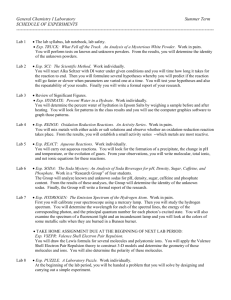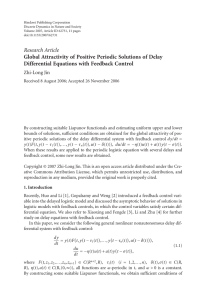. Los Alamos Days ’92 SYMBOLIC SOFTWARE FOR
advertisement
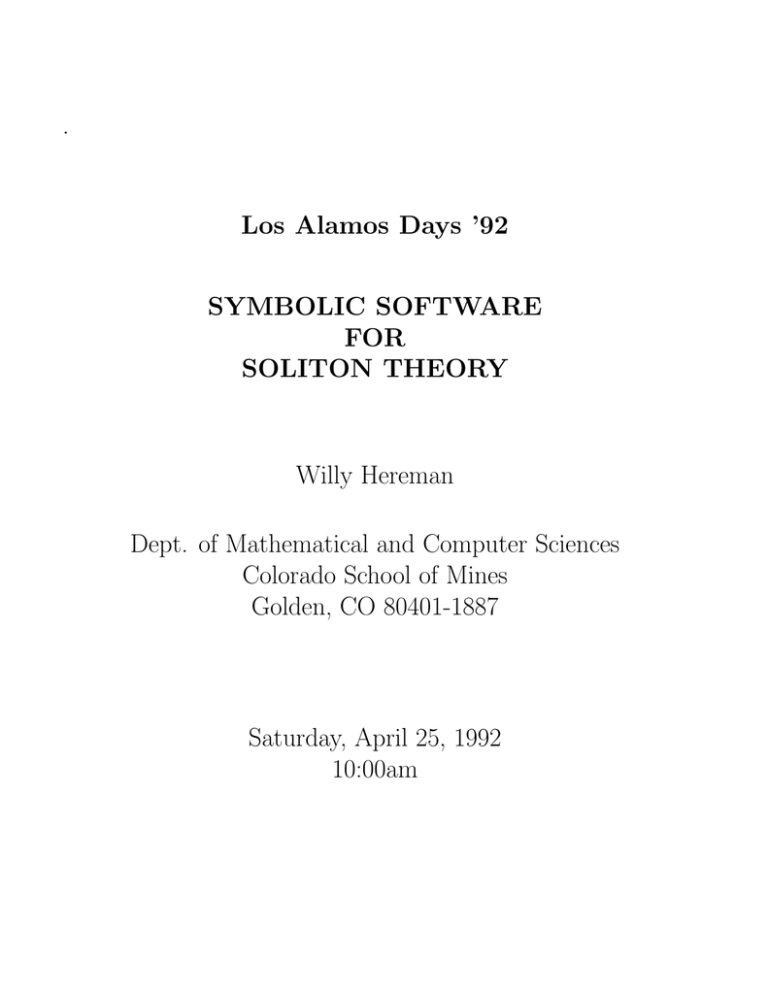
.
Los Alamos Days ’92
SYMBOLIC SOFTWARE
FOR
SOLITON THEORY
Willy Hereman
Dept. of Mathematical and Computer Sciences
Colorado School of Mines
Golden, CO 80401-1887
Saturday, April 25, 1992
10:00am
Symbolic Software Packages for Soliton Theory
• Painlevé Integrability Test of ODEs and PDEs
– Painlevé Test for 3rd order equations
by Hajee (Reduce, 1982)
– ODE Painlevé by Winternitz and Rand
(Macsyma, 1986)
– PDE Painlevé by Hereman and Van de Bulck
(Macsyma, 1987)
– Painlevé program (parts) by Hlavatý (Reduce, 1986)
• Construction of Explicit Solitary Wave and Soliton Solutions
– Solitary wave solutions by Hereman (Macsyma, 1990)
– Solitons via Hirota’s method by Hereman and Zhuang
(Macsyma, 1990)
• Calculation of Lie-point and Generalized Symmetries
– SPDE by Schwarz (Reduce, Scratchpad, 1986)
– Symmetries via exterior differential forms
by Kersten and Gragert (Reduce, 1987)
– Lie-Bäcklund symmetries by Fedorova, Kornyak and
Fushchich (Reduce, 1987)
– Lie-point symmetries by Schwarzmeier
and Rosenau (Macsyma, 1988)
– Special symmetries by Mikhailov (Pascal, 1988)
– LIE by Head (muMath, 1990)
– PDELIE by Vafeades (Macsyma, 1990)
– DEliA by Bocharov (Pascal, 1990)
– SYM DE by Steinberg (Macsyma, 1990)
– SYMCAL by Reid (Macsyma, 1990)
– SYMMGRP.MAX by Champagne, Hereman and Winternitz (1990)
Classes of Bilinear Equations
Major types of bilinear representations with examples:
Type I: Korteweg-de Vries equation
P (Dx, Dt)(f ·f ) ex.
= (DxDt + Dx4 )(f ·f ) = 0
Type II: modified Korteweg-de Vries equation
P1(Dx, Dt)(f ·g) ex.
= (Dt + Dx3 )(f ·g) = 0,
P2(Dx, Dt)(f ·g) ex.
= Dx2 (f ·g) = 0
Type III: sine-Gordon equation
P1(Dx, Dt)(g·f ) ex.
= (DxDt − 1)(g·f ) = 0,
P2(Dx, Dt)(f ·f − g·g) ex.
= DxDt(f ·f − g·g) = 0
Type IV: Nonlinear Schrödinger equation
P1(Dx, Dt)(g·f ) ex.
= (Dx2 + iDt)(g·f ) = 0,
P2(Dx, Dt)(f ·f ) − P3(Dx, Dt)(g·g ∗) ex.
= Dx2 (f ·f ) − gg ∗ = 0
Type V: Benjamin-Ono equation
P (Dx, Dt)(f ·f ∗) ex.
= (Dx2 + iDt)(f ·f ∗) = 0
For equations of Type II, the three-soliton solution
follows from
f =
−
−
g =
−
+
1 + i exp θ1 + i exp θ2 + i exp θ3
a12 exp(θ1 + θ2) − a13 exp(θ1 + θ3) − a23 exp(θ2 + θ3)
ib123 exp(θ1 + θ2 + θ3),
1 − i exp θ1 − i exp θ2 − i exp θ3
a12 exp(θ1 + θ2) − a13 exp(θ1 + θ3) − a23 exp(θ2 + θ3)
ib123 exp(θ1 + θ2 + θ3).
For equations of Types I, III through V
other forms for f and g are needed
Example 1 - Macsyma
Soliton Solutions of Nonlinear PDEs
• Hirota’s Direct Method
allows to construct exact soliton solutions of
– nonlinear evolution equations
– wave equations
– coupled systems
• Test conditions for existence of soliton solutions
• Examples:
– Korteweg-de Vries equation (KdV)
ut + 6uux + u3x = 0
– Kadomtsev-Petviashvili equation (KP)
(ut + 6uux + u3x)x + 3u2y = 0
– Sawada-Kotera equation (SK)
ut + 45u2ux + 15uxu2x + 15uu3x + u5x = 0
Hirota’s Method
Korteweg-de Vries equation
ut + 6uux + u3x = 0
Substitute
∂ 2 ln f (x, t)
u(x, t) = 2
∂x2
Integrate with respect to x
2
f fxt − fxft + f f4x − 4fxf3x + 3f2x
=0
Bilinear form
def
B(f ·f ) = DxDt +
Dx4
(f ·f ) = 0
Introduce the bilinear operator
m
n
Dxm Dtn(f ·g) = (∂x − ∂x0) (∂t − ∂t0) f (x, t) g(x0, t0)|x0=x,t0=t
Use the expansion
f =1+
∞
X
n=1
n fn
Substitute f into the bilinear equation
Collect powers in (book keeping parameter)
O(0) : B(1·1) = 0
O(1) : B(1·f1 + f1·1) = 0
O(2) : B(1·f2 + f1·f1 + f2·1) = 0
O(3) : B(1·f3 + f1·f2 + f2·f1 + f3·1) = 0
O(4) : B(1·f4 + f1·f3 + f2·f2 + f3·f1 + f4·1) = 0
O(n) : B(
n
X
j=0
fj ·fn−j ) = 0
with f0 = 1
If the original PDE admits a N-soliton solution
then the expansion will truncate at level n = N provided
f1 =
N
X
i=1
exp(θi) =
N
X
i=1
exp (ki x − ωi t + δi)
ki, ωi and δi are constants
Dispersion law
ωi = ki3
(i = 1, 2, ..., N )
Consider the case N=3
Terms generated by B(f1, f1) justify
f2 =
=
+
+
a12
a12
a13
a23
exp(θ1 + θ2) + a13 exp(θ1 + θ3) + a23 exp(θ2 + θ3)
exp [(k1 + k2) x − (ω1 + ω2) t + (δ1 + δ2)]
exp [(k1 + k3) x − (ω1 + ω3) t + (δ1 + δ3)]
exp [(k2 + k3) x − (ω2 + ω3) t + (δ2 + δ3)]
Calculate the constants a12, a13 and a23
(ki − kj )2
aij =
(ki + kj )2
i, j = 1, 2, 3
B(f1·f2 + f2·f1) motivates
f3 = b123 exp(θ1 + θ2 + θ3)
= b123 exp [(k1 +k2 +k3)x−(ω1 +ω2 +ω3)t+(δ1 +δ2 +δ3)]
with
b123
(k1 − k2)2 (k1 − k3)2 (k2 − k3)2
= a12 a13 a23 =
(k1 + k2)2 (k1 + k3)2 (k2 + k3)2
Subsequently, fi = 0 for i > 3
Set = 1
f = 1 + exp θ1 + exp θ2 + exp θ3
+ a12 exp(θ1 + θ2) + a13 exp(θ1 + θ3) + a23 exp(θ2 + θ3)
+ b123 exp(θ1 + θ2 + θ3)
Return to the original u(x, t)
∂ 2 ln f (x, t)
u(x, t) = 2
∂x2
Example 2 - Macsyma
Solitary Wave Solutions
• Korteweg-de Vries equation and generalizations
ut + aunux + uxxx = 0,
n ∈ IN
c(n + 1)(n + 2)
2 n√
sech
c(x − ct) + δ
u(x, t) =
2a
2
1
n
• Burgers equation
ut + auux − uxx = 0
c
c
u(x, t) = 1 − tanh (x − ct) + δ
a
2
• Fisher equation and generalizations
ut − uxx − u(1 − un) = 0,
u(x, t) =
n ∈ IN
n
(n + 4)
1
√
√
1
−
tanh
(x
−
t) + δ
2
2 2n + 4
2n + 4
2
n
• Fitzhugh-Nagumo equation
ut − uxx + u(1 − u)(a − u) = 0
u(x, t) =
a
(2 − a)
a
√
√ t) + δ
1
+
tanh
(x
−
2
2 2
2
• Kuramoto-Sivashinski equation
ut + uux + auxx + buxxxx = 0
165ak
3 k(x − ct)
tanh
+ δ
u(x, t) = c +
19
2
135ak
k(x − ct)
−
tanh
+ δ
19
2
with k =
s
11a
19b
15ak
3 k(x − ct)
tanh
+δ
19
2
45ak
k(x − ct)
+
tanh
+ δ
19
2
u(x, t) = c −
with k =
s
−a
19b
• Harry Dym equation
ut + (1 − u)3uxxx = 0
2 1 √
u(x, t) = sech
c [x − ct + δ(x, t)]
2 √
2
c
[x − ct + δ(x, t)]
δ(x, t) = √ tanh
c
2
• sine-Gordon equation
utt − uxx − sin u = 0
1
√
u(x, t) = 4 arctan exp
(x − ct) + δ
−c
• Coupled Korteweg-de Vries equations
ut − a(6uux + uxxx) − 2b vvx = 0,
vt + 3uvx + vxxx = 0
2
√
c(x − ct) + δ ,
u(x, t) = 2 c sech
v
u
u
√
u −2(4a + 1)
u
v(x, t) = ±ct
sech c(x − ct) + δ ,
b
2 1 √
u(x, t) = c sech
c(x − ct) + δ
2
√
3
3c
1
v(x, t) = r
u(x, t) = r
sech2 c(x − ct) + δ
2
6|b|
6|b|
• A class of generalized KdV equations
ut + (a + bum)umux + u3x = 0
with a, b ∈ IR; m ∈ Q
– CASE 1: a 6= 0, b = 0 :
∆ m1
c(m + 2)(m + 1)
2 m√
c(x − ct) + ]}
u(x, t) = {
sech [
2a
2
2
with arbitrary velocity c
– CASE 2: b 6= 0 :
u(x, t) = {
−a(2m + 1)
∆ 1
m√
(1−tanh[
c(x−ct)+ ])} m
2b(m + 2)
2
2
a2(2m + 1)
with c = −
b(m + 1)(m + 2)2
Example 4 - Macsyma
Lie-point Symmetries
• System of m differential equations of order k
∆i(x, u(k)) = 0,
i = 1, 2, ..., m
with p independent and q dependent variables
x = (x1, x2, ..., xp) ∈ IRp
u = (u1, u2, ..., uq ) ∈ IRq
• The group transformations have the form
x̃ = Λgroup (x, u),
ũ = Ωgroup (x, u)
where the functions Λgroup and Ωgroup are to be determined
• Look for the Lie algebra L realized by the vector field
q
∂
∂
X
+ ϕl (x, u) l
α=
η (x, u)
i=1
∂xi l=1
∂u
p
X
i
Procedure for finding the coefficients
• Construct the k th prolongation pr(k)α of the vector field α
• Apply it to the system of equations
• Request that the resulting expression vanishes
on the solution set of the given system
pr(k)α∆i |∆j =0
i, j = 1, ..., m
• This results in a system of linear homogeneous PDEs
for η i and ϕl , with independent variables x and u
(determining equations)
• Procedure thus consists of two major steps:
deriving the determining equations
solving the determining equations
Procedure for Computing the Determining Equations
• Use multi-index notation J = (j1, j2, ..., jp) ∈ INp,
to denote partial derivatives of ul
|J| l
∂
u
l
uJ ≡
,
∂x1j1 ∂x2j2 ...∂xpjp
where |J| = j1 + j2 + ... + jp
• u(k) denotes a vector whose components are all the partial
derivatives of order 0 up to k of all the ul
• Steps:
(1) Construct the k th prolongation of the vector field
(k)
pr α = α +
q X
X
l=1 J
ψlJ (x, u(k))
∂
,
∂ulJ
1 ≤ |J| ≤ k
The coefficients ψlJ of the first prolongation are:
ψlJi
= Diϕl (x, u) −
p
X
j=1
ulJj Diη j (x, u),
where Ji is a p−tuple with 1 on the ith position and zeros
elsewhere
Di is the total derivative operator
q X
∂
∂
X
+
ulJ+Ji l , 0 ≤ |J| ≤ k
Di =
∂xi l=1 J
∂uJ
Higher order prolongations are defined recursively:
ψlJ+Ji
=
DiψlJ
−
p
X
j=1
ulJ+Jj Diη j (x, u),
|J| ≥ 1
(2) Apply the prolonged operator pr(k)α to each
equation ∆i(x, u(k)) = 0
Require that pr(k)α vanishes on the solution set of the system
pr(k)α ∆i |∆j =0 = 0 i, j = 1, ..., m
(3) Choose m components of the vector u(k),
say v 1, ..., v m, such that:
(a) Each v i is equal to a derivative of a ul (l = 1, ..., q)
with respect to at least one variable xi (i = 1, ..., p).
(b) None of the v i is the derivative of another one in the
set.
(c) The system can be solved algebraically for the v i in
terms of the remaining components of u(k), which we de-
noted by w:
v i = S i(x, w),
i = 1, ..., m.
(d) The derivatives of v i,
vJi = DJ S i(x, w),
where DJ ≡ D1j1 D2j2 ...Dpjp , can all be expressed in terms
of the components of w and their derivatives, without ever
reintroducing the v i or their derivatives.
For instance, for a system of evolution equations
uit(x1, ..., xp−1, t) = F i(x1, ..., xp−1, t, u(k)),
i = 1, ..., m,
where u(k) involves derivatives with respect to the variables
xi but not t, choose v i = uit.
(4) Eliminate all v i and their derivatives from the expression prolonged vector field, so that all the remaining
variables are independent
(5) Obtain the determining equations for η i(x, u) and
ϕl (x, u) by equating to zero the coefficients of the remaining independent derivatives ulJ .


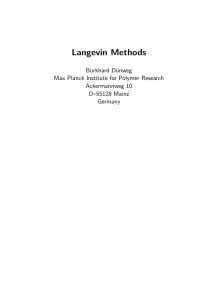
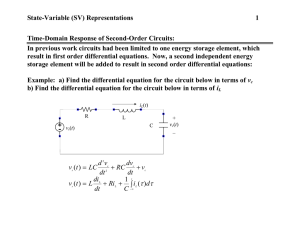
![Chem_Test_Outline[1]](http://s2.studylib.net/store/data/010130217_1-9c615a6ff3b14001407f2b5a7a2322ac-300x300.png)
